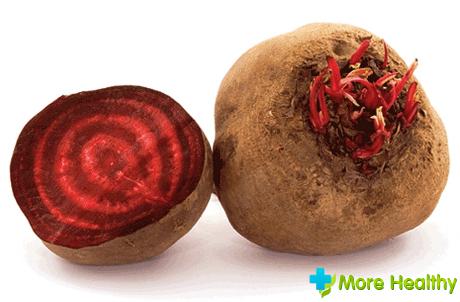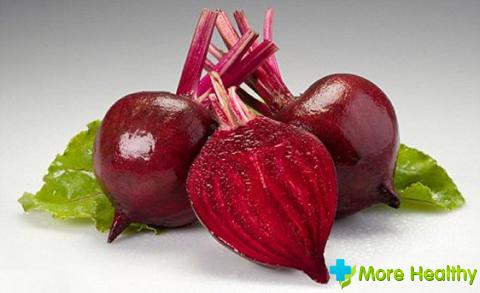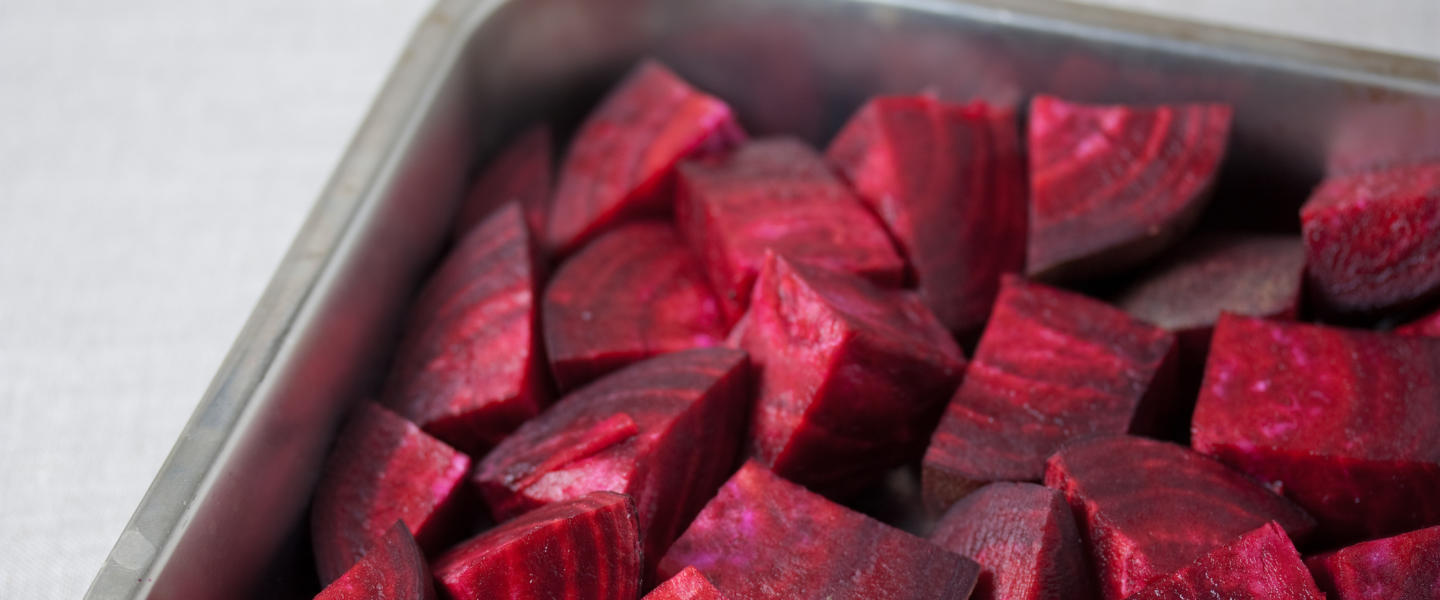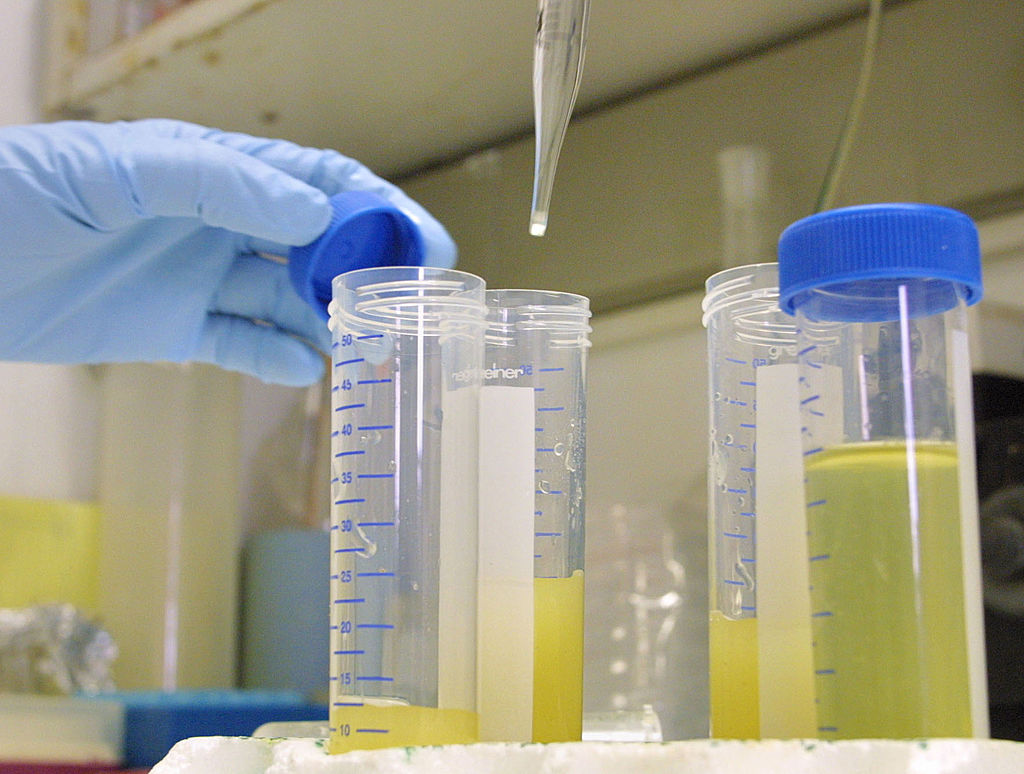If after eating beets the color of the urine is red. Causes of the red tint
The color and smell of urine can tell about a patient's health. When a patient undergoes an examination, the first thing to pass is this. If more serious diseases are suspected, the doctor prescribes a specific urine test for sugar and bakposev.
Most often, the color of urine is affected not by the consumption of beets, but by the use of beetroot juice. It is useful and has a beneficial effect on the body. Immediately after preparation, beetroot juice is not recommended to drink due to high content volatile substance. It can harm the body, so you should take the juice no earlier than two hours later.
For many, red urine occurs after eating beetroot dishes, such as vinaigrette or herring under a fur coat. Is urine staining in this color considered the norm and is it a symptom of pathology? There are two opinions on this:
- Pink or red color of urine is not normal and indicates a violation of the functioning of the kidneys. In such a situation, you should seek the advice of a specialist.
- Immediately, without examination, not a single doctor will give an exact guarantee that a person is all right. The analysis may show a violation of the kidneys. However, not all patients from the consumption of beets change the color of urine, and not all of them are a symptom of kidney disease: pain in the abdomen or back.
Some claim that after kidney treatment and kidney infections the color returns to normal and the urine becomes yellow. What properties of urine do they pay attention to when examining the analysis?
Characteristics of urine by properties
- quantity;
- density;
- transparency;
- smell;
- color.
The amount of urine excreted per day is normally one and a half liters. A deviation from the norm up or down indicates the presence of dysfunction in the body. If urine is not excreted or its amount per day is not more than 50 milliliters, then this is a symptom of illness, and the patient needs immediate treatment.
The density of urine increases in the presence of glucose or other osmotically active substances. A decrease in the density of urine occurs with acute damage to the renal tubules.
At healthy patient urine is clear. If you do not consume during the day enough water, urine becomes saturated yellow. Usually this sign is not a signal that a person is sick. And when replenished water balance urine returns to its natural tone. Urine takes cloudy appearance, foams in the presence of protein, pus or salt crystals in it, which are signs of the presence of a disease.

AT healthy condition urine has a slight specific smell. If the patient is unwell, the nature of the smell changes. At diabetes it acquires a specific fruity smell.
Normally, the color has a shade from pale yellow to a rich straw shade. During the day, urine has a different shade, which depends on the amount of fluid consumed and food intake. In the morning, urine has a darker shade than in the rest of the day.
Why can urine from beets be pink and red?
Many are afraid of reddish urine after beets. Why is this happening and is there any reason to worry about it? Many experts have different opinions on this matter.
Some believe that when the urine is stained after consuming beets, this is the norm. Others say that in a healthy patient, urine should be yellow, even after consuming this vegetable, and the presence indicates dysbacteriosis. There is also an opinion that the red color after the consumption of beets indicates the presence kidney disease. There is a possibility that after eating beets, urine is stained due to the presence of iron deficiency anemia in a person.
How to understand that urine turned red from beets?
There is a way to help identify the cause of the redness of the urine and understand if there is blood in it or if the staining came from the consumption of beets. To conduct the experiment, you will need soda, vinegar and urine. First, add soda to the urine, and then pour a little vinegar. If after adding soda the color disappeared, and after vinegar it reappeared, then the reason for the change in color lies not in the admixture of blood in the urine, but in the consumption of beetroot dishes.
By the state of urine, one can often judge the general state of human health. That is why during various preventive examinations doctors prescribe to patients general analysis urine, and if some diseases are suspected, more specific tests are prescribed, such as, for example, a urinalysis for sugar or bacteriological culture urine.
Physical properties of urine
By physical condition urine is characterized by quantity, transparency, density, color and smell:
- Quantity
Daily urine output by a healthy person averages 1.5 liters. Significant decrease or increase daily diuresis causes violations normal functioning organism. The absence of urine, or its amount is not more than 50 ml per day, is a serious threat, as it is a symptom of a number of diseases that require immediate treatment.
- Transparency
The hallmark of urine healthy person is its transparency. Insufficient fluid intake causes temporary cloudiness of the urine and is not a sign of any disease. As a rule, after taking the necessary fluid for the body, urine acquires transparent view. The turbid and frothy appearance of the urine is given by the proteins in it, crystalline substances and pus, it is a symptom of various diseases.
- Density
The presence in it, as well as substances that enter the urine due to intravenous infusion, leads to an increase in the density of urine. Renal and acute damage to the renal tubules are the cause of a decrease in the density of urine.
The normal color of a healthy person's urine ranges from clear white to straw yellow. Urine tends to change color depending on the time of day, the amount of liquid consumed, and also on the composition of the food. So, for example, morning urine is always darker than urine during the day, which is always lighter in color.
- Smell
Normally, urine has a specific mild odor. Various diseases can change its smell. For example, in diabetes, urine smells like rotting apples.
Reasons for changing the color of urine

Urine color may be affected by medications used for various diseases, the presence of diseases and products containing dyes:
- Brown-red color. Due to the admixture of blood in the urine with glomerulonephritis, kidney stones, and tumors.
- Pink and reddish color. The reason for this color may be food with red pigments - blueberries, blackberries, red peppers, beets, pastries with rhubarb.
- Yellow-green color. It is observed with a significant content of pus in the urine and while taking anti-inflammatory drugs and antidepressants. The reason for the green color of urine may be an increase in bilirubin, which is a signal of liver and pancreas disease. Greenish color urine comes from eating asparagus and spinach.
- White color. Associated with large quantity in the urine of phosphates and calcium phosphate salts, which indicates a violation of calcium-phosphorus metabolism. In the presence of pus in the urine, its color may take on a grayish tint.
- Bright orange color. It happens when taking medications that thin the blood, as well as when consuming a large amount of beta-carotene contained in carrots.
Red coloration of urine after eating beets
Many people are frightened when they see red urine after taking beets. But is there really cause for concern? There is no single answer to this question, and even experts have different opinions on this issue.

Some of them believe that red urine after eating beets is quite normal. Others say that in a healthy person, urine after beets does not change color, and red color indicates the presence of dysbacteriosis. There is also an opinion that the red color of urine after taking beets means that a person has problems with the kidneys. Another theory claims that urine staining after eating beets is one of the signs of iron deficiency anemia.
How to determine the cause of red urine
To remove all doubts from what urine turned red (from the presence of blood in it or from beets) can be simple and very fast way. A small amount of drinking soda it is necessary to pour into the urine, and then add table vinegar. If the color from the soda has disappeared and reappeared after the addition of vinegar, then the cause of the red color of the urine is the beets eaten, and not the blood.
Attention should also be paid to the fact that urine, reddened from taking beets, is transparent, and has a cloudy appearance due to the presence of blood.
In order to determine whether there are actually diseases such as dysbacteriosis, Iron-deficiency anemia or kidney problems, the symptoms of which may be redness of the urine after taking beets, you should consult a doctor. Required tests and diagnostics will help determine the cause of the change in urine color.
Is it normal to have red urine after eating beets? Ideally, urine has a yellow color and a specific smell, but in some cases, its shade can change. The color of urine is influenced by the food and drinks consumed, but can also give it an unusual color and various ailments in the body. You can find out the true cause of the deviation from the norm only by passing biological material for analysis in the laboratory.
Coloring urine from beets - normal phenomenon.
Can urine be stained from beets?
Does this bright root crop stain the urine of a child and an adult? If it was noticed that the urinary fluid turned red or turned pink after eating beets, then it is likely that this particular product provoked the staining, since it side effect just considered a change in the color of urine. However, the shade of urine does not always change due to concentrated vegetables, so you need to monitor how long it lasts and how often red urine appears.
Causes of urine coloration
Why does the urinary fluid turn red after a meal in which beets were present? It is believed that this vegetable can change the color of urine in adults, children, men and women, as it has the strongest pigment, the excretion of which is carried out by the kidneys with urine. The opinions of doctors differ, and if some believe that it is bad when urine turns red after taking beets, then others argue that changing the color of urine when coloring foods are the cause of the transformation is the norm and there is no threat to human life.
Doctors believe that urine can be red from beets if the person who ate it was diagnosed with dysbacteriosis. They say that in a healthy person, urine will not change its color after eating a bright root crop. Reddish or is a symptom of serious ailments, and occurs due to the penetration of blood into it during bleeding organs genitourinary system. But the opinion that there is red urine from beets has a right to exist, and not always the cause of colored urinary fluid is pathological changes inside the body. In addition to beets, the urine of a woman and a man is able to color rhubarb, carrots and other foods, which contain pigments that change the shade of the urinary fluid.
 The burgundy color of urine after eating beets is due to the presence of strong coloring components in the vegetable.
The burgundy color of urine after eating beets is due to the presence of strong coloring components in the vegetable.
Causes of the red tint
In some cases, after eating a vinaigrette, in the recipe of which the main ingredient is beetroot, the urine changes its color and becomes not habitually yellow, but red. Based on this, many are interested in why it acquires such a shade? There is a transformation of the urinary fluid into a purple color due to the presence of a group of betacyanins in the root crop, in which betanin performs the function of color saturation. It is even used as a natural food coloring to give food a bright red or blue-violet color.
AT acidic environment the pigment is sensitive to oxidative degradation, so the color of the urine depends on the time required to process the root and the acidity of the stomach. Therefore, red urine after eating beets is normal, since betacyanins are not decomposed in every person in the digestive system. After that, the compounds are absorbed into the large intestine through the intestinal walls, and then, penetrate into the blood, pass the filter by the kidneys and enter the urine. It is possible that the degradation of betacyanins is influenced by environmental and genetic factors. But there are other conditions under which beets color the urinary fluid:
- the volume of diuresis affecting the concentration of the coloring agent:
- medicines that change stomach acidity;
- other foods containing in large numbers coloring components;
- the presence of oxalic acid in food.
Symptoms
 Without the use of coloring products, human urine should not have a contrasting color.
Without the use of coloring products, human urine should not have a contrasting color. As you know, beets are able to stain the urinary fluid in people who do not have health problems. But sometimes an atypical shade of urine still indicates pathological changes in the body, so it would be useful to take tests to exclude possible causes changes colors. Along with redness of the urine, the following symptoms may occur:
- frequent stool;
- discomfort in the stomach;
- painful bloating;
- hematuria with a negative result for the presence of blood in the urine.
At home, where there is not always enough space for bulky tomographs and X-ray machines, you can still judge your human health, for example, with the help of urine. It is believed that the color and smell of urine produced by the kidneys before midnight depends mainly on food, and in urine that appeared after midnight, various diseases organism. Therefore, to obtain relatively reliable and effective findings, urine should be collected early in the morning. Healthy urine has a light yellow, straw color and a slight smell of ammonia. If the properties of the collected urine have deviations from these indicators, this is either evidence of the presence of a disease, or physical changes organism.
For example, red urine may appear after eating beets because beets contain an intense pigment that is excreted in the urine. However, there are also some additions here, since many doctors believe that urine staining red after beets means that a person has a, and a completely healthy person has urine color, according to at least not so intense.
Is red urine from beets?
Naturally, you should be alarmed, because if the color of urine is brown or red, it can be triggered by blood impurities, which makes you suspect kidney stones, glomerulonephritis, pyelonephritis. This color is also possible when taking certain medications, with hepatitis, a number of tumors and hemolytic anemia.
However, do not immediately hesitate and panic. You can continue to continue research in your home laboratory. If added to urine a small amount of baking soda and stir. Next, a little should be added to the resulting solution. acetic acid. If, after these procedures, and then returned again, it means that the reason for such colorful effects really lies in the beets.
However, the final point in your experiments should be put by the doctor. The fact is that even if the red color appeared precisely due to the use of beets, this may mean that very often a similar effect accompanies iron deficiency in the body.
However, these may be signs and more serious illnesses. In particular, blood in the urine of an adult is considered by many doctors as one of the symptoms of cancer.
Red color of urine and causes
Red urine may also appear under the influence of salts. If available great content urates or uric acid, the urine may acquire a red color with a brick tint. The appearance of blood in the urine is called hematuria. A specific affected organ can be judged by the intensity of the red color and the form of the detected blood, which can be presented in the form of clots, threads and other fragments. In particular, shapeless blood clots indicate, and thread-like ones indicate the onset of bleeding of the kidney or upper urinary tract.
That is, you should rejoice if your urine is really from beets. However, it is better to check the results of your research with full-fledged medical research, in other words, having determined any abnormalities in your body, in particular, red urine, it is better to visit a doctor.
Can there be red urine after beets? The urinary system, its functioning directly depends on what a person eats. The quantity, color and quality of urine may vary depending on the food, daily diet. After eating beets, urine may be red or similar in color to the food. Such indicators are in most cases considered the norm, but there may be exceptions that are not associated with the presence of a vegetable in the diet.
Can urine be colored in a characteristic color? Of course yes, because the kidneys process all products, from which the structure of urine changes.
Vegetables and fruits, of course, must be present in daily diet nutrition, they have many useful qualities and simply indispensable wellness person. Beetroot is a complex of vitamins, microelements, it has a mass useful properties. It is actively used in the diet of children, athletes, preparing various dishes and making juice. This vegetable has antioxidant properties, can improve performance, but can stain urine.
The reasons for this phenomenon are quite understandable, they can be distinguished by the following points:Why does urine turn red after eating beets? This is normal and may natural process metabolism in the kidneys. The composition of urine can change, because it consists of the remnants of processed food.
- a large amount of betanin;
- a large amount of product with a characteristic color;
- taking medications;
- genetic predisposition;
- environmental factor.
In addition to the main points, the reasons can be hidden in quite familiar actions: improper storage, canned food, the type of vegetable itself, of course, can affect the color of urine, staining it. At hyperacidity urine turns red more often. This phenomenon can last about two days, while nothing can affect this indicator.
Why does beetroot make urine red? The reasons for staining urine can be different and most of them are related to heredity, as well as the selected vegetable.
Symptoms of changes
After beets, red urine is considered normal if this indicator does not hide any diseases.
In case there are additional symptoms, a person needs to seek help from a specialist, as well as pass all the necessary laboratory tests.
The main signs that began to cause concern:- Cutting in the abdomen, bloating and discomfort, which may intensify.
- loose stool and frequent urges the toilet is also a deviation after eating a vegetable.
- Urine is dyed bright color, may contain various impurities.
Such indicators cannot be the norm and need to be medical diagnostics. The structural composition of urine is important diagnostic marker, which points to general state the whole organism. When diagnosing diseases, laboratory analysis urine is compulsory procedure. True reasons Deviations can only be explained by specialists after the examination. Unpleasant signs may appear, after which the urine changes color. Such a condition, of course, is considered a manifestation of the disease and needs to be corrected by a specialist.
Coloring pigment can change the color of urine, but red urine is not always normal. It is worth carefully studying additional symptoms.
Red or pink urine after beets may be normal, but sometimes this composition indicates an imbalance in the body. When staining urine, other signs may appear that indicate a lack of nutrients in the body.
Women and men experience similar symptoms, namely:
- constant fatigue;
- pallor of the skin;
- inability to concentrate.
Such indicators arise due to a lack of iron, and also indicate various diseases, even if urine from beets changes color.
But if the beets were not eaten, and the urine has a characteristic shade, then this indicates the development of pathology, namely:- changes in the genitourinary system;
- infectious diseases;
- intoxication;
- kidney disease.
In any case, why urine changes color is better to consult a specialist. But don't rule out healthy vegetable from the diet. The coloration of urine is the result of beet enzymes, which are processed into excretory system person.




